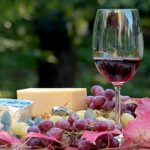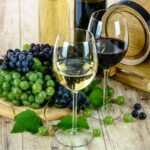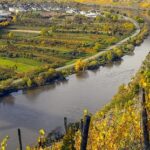
Germany may be best known for its beer gardens and steins, but for travelers in the know, it’s the wine valleys of the Rhine and Mosel that offer the country’s most enchanting journeys. Here, rows of vines snake up sun-drenched slopes, medieval towns dot the riverbanks, and a crisp glass of Riesling tells the story of centuries-old winemaking traditions. This is the heart of German viticulture – and your starting point for a cultural and culinary adventure through Germany’s most iconic wine regions.
Whether you’re a dedicated oenophile or a curious traveler, this comprehensive guide will lead you through the Rhine and Mosel valleys, introduce you to essential wine knowledge, and connect you to a complete five-article series designed to enhance your exploration.
Why the Rhine and Mosel Valleys Matter
The Rhine and Mosel regions are not just the most famous wine-producing areas in Germany – they are cultural and historical landscapes in their own right. For more than two millennia, these valleys have cultivated vines, traded wines across Europe, and shaped the very identity of German wine.
- The Rhine Valley is known for its grand castles, noble Rieslings, and vibrant wine towns like Rüdesheim and Bacharach. It offers a broad, scenic river flanked by vineyard-covered hills and accessible wine estates.
- The Mosel Valley, on the other hand, is more intimate and dramatic – its steep slate vineyards cling to twisting riverbanks, producing some of the world’s most elegant and aromatic white wines.
Both regions are celebrated for:
- World-class white wines, especially Riesling
- Generational winemaking families and small-batch estates
- Wine festivals, open-cellar days, and riverside tastings
- Fairy-tale villages, Roman ruins, and UNESCO-listed landscapes
A Cultural Landscape of Vines and Villages
The charm of Germany’s wine regions lies in their harmony between landscape and tradition. The terraced vineyards you see today were carved over generations, shaped by monastic orders, noble families, and peasant farmers who all left their mark on the soil – and in the glass. Churches, wine presses, ancient cellars, and ornate barrels offer visitors a tangible connection to the region’s past.
The people of these valleys are proud custodians of centuries-old winemaking knowledge. Many estates are family-run, passed down through generations who live and breathe the rhythms of the vineyard. From spring pruning to autumn harvest, every bottle of German wine is a reflection of its land and legacy.
Rhine vs. Mosel: Key Differences at a Glance
| Feature | Rhine Valley | Mosel Valley |
|---|---|---|
| Wine Style | Bold, mineral-rich Riesling | Light, elegant Riesling |
| Landscape | Wide river, terraced hills, grand castles | Steep vineyards, winding river, cozy towns |
| Top Towns | Rüdesheim, Bacharach, Koblenz | Bernkastel-Kues, Cochem, Traben-Trarbach |
| Red Wine Presence | Spätburgunder (Pinot Noir) in warmer areas | Minimal – focus is on whites |
| Ideal For | First-time visitors, castle-hopping, variety | Wine purists, scenic charm, quiet escapes |
Best Times to Visit
May through October is ideal for wine travel. Spring brings vineyard blooms and fewer crowds, while autumn (especially late September to mid-October) is peak harvest season – with golden leaves, fresh wines, and lively festivals.
What to Drink Where
- Rhine Valley: Dry Riesling (Trocken), Spätlese, and Pinot Noir from Assmannshausen
- Mosel Valley: Delicately sweet Kabinett and Spätlese Rieslings, along with rare Elbling and Müller-Thurgau
- Don’t miss Sekt, Germany’s lively sparkling wine, often made from Riesling grapes
Wine Culture and Traditions
Wine is woven into the social and cultural life of both valleys:
- Straußwirtschaften: Seasonal, family-run taverns that serve homemade wines and rustic food
- Wine trails: Well-marked hiking and cycling paths connecting vineyards and tasting rooms
- Weinfeste: Village festivals celebrating wine harvests, often with music, dancing, and regional food
- Roman Wine Heritage: Archaeological sites and museums that showcase ancient viticulture
How to Travel the Regions
- By car: Offers flexibility to visit off-the-path wineries and stay in remote guesthouses
- By river cruise: Scenic, relaxing, and perfect for castle-spotting
- By train: Especially good in the Rhine Valley with frequent connections between towns
- By bike or foot: Numerous trails along both rivers cater to active travelers and offer immersive vineyard access
Where to Stay
Stay in Weingut guesthouses (winery stays), historic inns, or riverside hotels. Popular towns include:
- Rhine: Rüdesheim, Boppard, Bacharach, Lorch
- Mosel: Bernkastel-Kues, Traben-Trarbach, Cochem, Zell
Traveler Tips
- Always check winery hours – many are family-run with limited opening times
- Bring cash – small towns and tasting rooms may not accept cards
- Ask for a “Probierpaket” – a tasting flight of the winery’s range
- Learn key terms: “Trocken” (dry), “Halbtrocken” (off-dry), “Weingut” (winery)
Don’t Just Taste the Wine – Live the Landscape
Hiking through vineyard paths, sipping Riesling on a river terrace, or chatting with a winemaker over a shared plate of sausages and cheese – these are the authentic moments that define Germany’s wine experience. Each vineyard has a view, and each view tells a story that stretches from the Roman Empire to the modern European wine renaissance.
Wine here is not flashy. It is confident in its clarity, its acidity, its balance. Just like the culture that surrounds it. If you want to understand German values – precision, pride, modesty, and joy in seasonality – you’ll find them all in a single glass.
Germany Beyond the Bottle
These wine regions are more than just grapevines – they’re gateways to German history, hospitality, and local life. You’ll walk Roman roads, tour medieval fortresses, sip under half-timbered rooftops, and meet winemakers whose families have cultivated the same slopes for generations.
Every Riesling tells a story. Every view invites a pause. And every stop along the river teaches you something new about German tradition, taste, and terroir.
So fill your glass and start your journey – Germany’s wine country is waiting.
Explore the Full Series:
- Exploring the Rhine Valley: Castles, Riesling, and Romantic Wine Towns
- Mosel Magic: Germany’s Most Scenic River for White Wine Lovers
- German Wine 101: Grape Varieties, Label Terms, and What to Drink
- When to Visit German Wine Country: Seasons, Festivals, and Travel Tips
- Wine Tourism in Germany: How to Taste Like a Local and Explore With Style
- Wine Festivals in Germany: Learn about the vibrant wine culture of the Rhineland.







